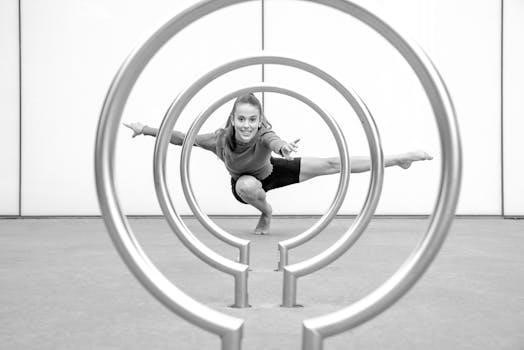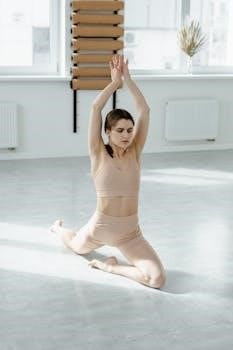Somatic Yoga is an embodied practice fusing movement and mindfulness․ It emphasizes internal sensations rather than achieving specific poses․ It promotes self-awareness‚ stress reduction‚ and overall well-being through gentle‚ intuitive movements․
What is Somatic Yoga?
Somatic Yoga‚ often called Embodied Yoga‚ is a practice that prioritizes your internal experience․ It focuses on the body’s sensations during movement‚ encouraging self-awareness․ Unlike traditional yoga‚ it is less about external alignment and more about exploring what feels good and pleasurable․ It blends movement with mindfulness‚ aiming to release tension and foster a deeper connection between mind and body‚ promoting healing․
Core Principles of Somatic Yoga
Somatic Yoga centers on internal awareness and gentle movement․ It emphasizes feeling sensations‚ not achieving specific poses․ It promotes self-compassion and a deep mind-body connection through mindful exploration․
Emphasis on Internal Awareness
Somatic yoga places a strong emphasis on internal awareness‚ encouraging practitioners to tune into their body’s sensations․ This involves noticing subtle shifts in muscles‚ breath‚ and overall physical feeling․ Unlike traditional yoga‚ the focus is less on achieving perfect postures and more on fostering a deep‚ personal connection with the body’s inner landscape․ This practice promotes self-understanding‚ emotional processing‚ and physical healing through mindful attention․
Gentle Movement Patterns
Somatic yoga utilizes gentle‚ slow movement patterns that prioritize comfort and ease․ These movements are exploratory and intuitive‚ encouraging practitioners to move in ways that feel natural and beneficial for their bodies․ Unlike more vigorous forms of exercise‚ somatic yoga promotes relaxation and reduces tension through mindful‚ low-impact motions․ The emphasis is on listening to the body’s cues and responding with gentle‚ compassionate movement․
Benefits of Somatic Yoga
Somatic yoga offers numerous benefits‚ including stress reduction and improved flexibility․ It enhances body awareness‚ promotes emotional healing‚ and offers pain relief through gentle movements and mindful breathing practices․
Stress and Tension Reduction
Somatic yoga is highly effective in reducing stress and tension by activating the parasympathetic nervous system through gentle movements and mindful breathing․ This promotes a relaxation response‚ soothing both body and mind․ It helps release muscular tension and stored emotions‚ fostering a sense of calm and well-being․ This practice can alleviate chronic stress and promote greater peace․
Improved Flexibility and Mobility
Somatic yoga enhances flexibility and mobility through gentle stretches and exploratory movements․ It focuses on releasing muscular tension and improving joint mobility‚ leading to a more fluid and vibrant body․ Unlike traditional yoga‚ it emphasizes feeling good from the inside out‚ promoting a greater range of motion․ This practice allows for increased physical freedom and ease of movement․
Pain Relief
Somatic yoga can effectively reduce pain by addressing chronic tension patterns․ Gentle movements and mindful breathing activate the parasympathetic nervous system‚ promoting relaxation and easing discomfort․ Studies suggest that somatic practices like yoga can decrease pain intensity and improve physical function․ This approach allows individuals to gain more control over their pain and find relief․

Somatic Yoga for Beginners
Starting with basic practices is key for beginners in Somatic Yoga․ Focus on deepening awareness and relaxation through short sessions‚ incorporating gentle movements and breathwork to ease into the practice․
Starting with Basic Practices
Begin with gentle‚ floor-based movements‚ focusing on internal sensations and breath․ Explore simple poses‚ paying attention to how your body feels‚ not how it looks․ Short sessions‚ around 10-15 minutes daily‚ are recommended for beginners․ Gradually increase the time as comfort and awareness grow․ This approach helps build a strong foundation for a deeper somatic yoga practice‚ fostering a mindful connection with your body․
Recommended Practice Frequency
For beginners‚ starting with a daily practice of 10-15 minutes is ideal․ Consistency is key to developing body awareness․ As you become more comfortable‚ you can gradually increase the duration and frequency of your practice․ Listen to your body and adjust as needed․ Even a short‚ regular session can provide significant benefits and enhance the mind-body connection․ Avoid overdoing it‚ especially when starting․
Creating a Somatic Yoga Sequence
Crafting a sequence involves setting an intention‚ warming up‚ and incorporating somatic movements․ Restorative poses and relaxation conclude the practice‚ fostering a deeper mind-body connection and promoting healing․
Setting an Intention
Before beginning your somatic yoga practice‚ take a moment to set an intention․ This could be anything from releasing tension to cultivating self-compassion․ Consider what you need from the practice and allow that to guide your movement․ Your intention should be personal and meaningful‚ enhancing your mind-body connection during the session․ It will focus the energy of your practice and make it more effective․
Warm-up and Breathwork
Begin your somatic yoga session with a gentle warm-up to awaken your muscles and joints․ Incorporate simple movements that feel good to your body and sync them with your breath․ Focus on slow‚ deep breaths to center yourself and invite awareness into the present moment․ This prepares your body for deeper exploration and promotes a sense of calm․ This step is crucial for connecting with your body․
Somatic Poses and Movements
Transition into somatic yoga poses‚ exploring different movements and sensations․ Focus on internal awareness‚ moving intuitively from one posture to the next․ These gentle movements help release tension‚ improve mobility‚ and foster a deeper mind-body connection․ Pay attention to your body’s feedback‚ adjusting as needed․ Remember‚ it’s about feeling‚ not achieving a perfect shape; embodiment practices that resonate with you are key․
Restorative Poses and Relaxation
As you conclude your practice‚ transition to restorative poses and calming breathwork․ These gentle postures soothe the nervous system‚ preparing you for deep relaxation․ Find a comfortable seated position or lie down‚ allowing yourself to fully integrate the benefits of your practice․ This phase allows for profound rest and absorption‚ enhancing the overall healing experience and promoting a sense of peace․

Where to Find Somatic Yoga Resources
Explore online classes and tutorials for guided practices․ Seek out local studios offering beginner-friendly somatic yoga courses․ Many free resources are available to support your journey․
Online Classes and Tutorials
Numerous online platforms offer somatic yoga classes suitable for beginners․ These resources provide guided practices‚ often including video demonstrations and instructions․ Look for classes specifically designed for newcomers to somatic movement; Many online tutorials offer free introductions to this approach‚ allowing you to explore at your own pace․ These digital tools often include variations for different needs․
Local Studios
Many local yoga studios now offer somatic yoga classes․ These in-person sessions allow for personalized guidance and adjustments from experienced instructors․ Check studio schedules for beginner-friendly classes‚ often labeled as “gentle” or “restorative․” Attending a local studio can foster a sense of community and provide a structured learning environment․ Some studios may offer introductory workshops on somatic principles․

Essential Equipment for Beginners
For starting somatic yoga‚ a comfortable yoga mat is crucial․ Optional equipment includes a yoga block‚ which can be helpful for support and alignment in certain poses․
Yoga Mat
A yoga mat provides a stable and cushioned surface‚ essential for comfort and safety during somatic yoga practices․ It helps to prevent slipping and supports joints during floor-based movements․ Opt for a mat that is non-slip and has appropriate thickness for your needs․ This will enhance your focus and comfort‚ allowing for a more effective practice․ The mat is foundational for exploring gentle movements and internal awareness‚ which are key to somatic yoga․
Optional Props (Block)
A yoga block is an optional‚ but helpful prop for somatic yoga beginners‚ as it aids in modifying poses and improving alignment․ It can support the body‚ enhancing comfort and allowing for deeper exploration of movements․ Blocks are particularly useful for those with limited flexibility or joint issues․ They can assist in gentle stretches and make poses more accessible‚ thereby supporting a safe and effective practice․ Using a block can also provide a deeper understanding of the somatic experience;
Somatic Yoga Poses for Beginners
Somatic yoga for beginners includes simple poses often done sitting or lying down․ These postures combine gentle movement and breathwork to increase body awareness and release tension․
Simple Poses (Sitting or Lying Down)
Beginners can explore somatic yoga with simple seated or lying poses․ These might include gentle rocking‚ pelvic tilts‚ or slow limb movements․ The focus is on noticing internal sensations and releasing tension․ These poses help cultivate body awareness‚ promote relaxation‚ and are accessible to all levels‚ allowing for a gentle introduction to somatic practices․ These movements are not about achieving a particular shape․
Breathing Techniques
Breathwork is a core component of somatic yoga‚ focusing on mindful breathing to enhance body awareness and relaxation․ Simple techniques like diaphragmatic breathing‚ where you feel the belly rise and fall‚ can be beneficial for beginners․ These exercises help calm the nervous system and deepen the connection between mind and body․ The goal is to breathe naturally and observe sensations․

Somatic Yoga & Mind-Body Connection
Somatic yoga cultivates a deep mind-body connection through internal awareness․ It encourages listening to the body’s cues‚ promoting self-compassion and emotional healing‚ fostering a sense of wholeness․
Cultivating Self-Awareness
Through somatic yoga‚ beginners learn to tune into their body’s subtle signals․ This process involves noticing sensations‚ emotions‚ and any tensions present․ This heightened awareness fosters a deeper understanding of the self‚ allowing for more informed and compassionate responses to physical and emotional needs․ It is a key component of somatic practice․
Emotional and Physical Healing
Somatic yoga facilitates healing by addressing the mind-body connection․ Gentle movements and mindful breathing release stored tension‚ which can alleviate physical pain and emotional distress․ By fostering a sense of safety and self-compassion‚ it empowers individuals to process emotions and promote overall well-being․ This holistic approach supports both physical and emotional recovery․
